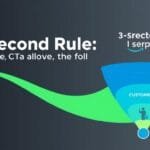What Are Heatmaps and Why Do They Matter?
Heatmaps are visual representations of user behavior on your website, showing where visitors click, move their cursor, and how far they scroll. Think of them as thermal images of your website – red areas indicate high activity, while blue areas show minimal interaction.
Hotjar Click Heatmap Example: Red areas indicate high click activity
Types of Heatmaps in Hotjar
Click Heatmaps
Click heatmaps reveal exactly where users are clicking on your page. They help identify if users are clicking on non-clickable elements (suggesting confusion) or missing important call-to-action buttons. This data is invaluable for optimizing button placement and improving navigation paths.
Move Heatmaps
Move heatmaps track cursor movements, which often correlate with eye movement. They show where users hover but don’t click, helping you understand what content captures attention but might not be compelling enough to drive action.
Scroll Heatmaps
Scroll maps show how far down your page visitors are scrolling. They reveal your “attention threshold” – the point where most users stop scrolling. This helps you ensure critical content appears above this threshold or create better incentives to scroll further.
Device-Specific Insights
Hotjar allows you to filter heatmaps by device type (desktop, tablet, mobile), helping you optimize for different user experiences across devices. This is crucial as mobile and desktop users often behave very differently.

Scroll Depth Analysis with Hotjar: See exactly where users stop scrolling
“Heatmaps show a variety of insights into user behavior on your site. They show what areas of your pages are getting lots of attention, and which are getting less. By showing where people are clicking, scrolling, tapping, and hovering, they display user behavior in a way you wouldn’t have otherwise seen.”
How Session Recordings Work
While heatmaps provide aggregate data, session recordings let you watch individual user journeys through your site. These recordings capture real user interactions including clicks, mouse movements, page scrolling, and form interactions – all anonymized to protect privacy.

Hotjar Session Recording Playback: Watch real users navigate your site
What Session Recordings Capture
- Mouse movements and clicks across your pages
- Scrolling behavior and hesitation points
- Form interactions, including field completion and abandonment
- Page-to-page navigation patterns
- Rage clicks (repeated frustrated clicking)
- U-turns (when users quickly go back after landing on a page)
Privacy and Security Considerations
Hotjar is designed with privacy in mind. You can configure it to automatically mask all text input fields to ensure sensitive information like passwords or credit card details is never captured. The tool also complies with GDPR and other privacy regulations, giving you control over what data is collected.
Pro Tip: When setting up recordings, filter for sessions with specific behaviors like form abandonment or visits to high-value pages to focus on the most insightful user journeys.
Analyzing Session Recordings Effectively
The real value of recordings comes from identifying patterns across multiple sessions. Look for common points of confusion, hesitation, or abandonment. Hotjar allows you to filter recordings by pages visited, device type, duration, and other criteria to help you focus on the most relevant sessions for your analysis.
Practical Applications: Solving Real UX Problems
The true power of Hotjar lies in its ability to identify and fix specific UX issues that impact your conversion rates. Here are some practical examples of how businesses use Hotjar to improve their websites:
1. Optimizing Form Completion Rates
A common challenge for many websites is form abandonment. By using Hotjar’s form analysis feature alongside recordings, you can identify exactly which fields cause users to drop off. One e-commerce company discovered that users were abandoning their checkout form at the phone number field – after making it optional, they saw a 23% increase in form completions.
2. Improving Call-to-Action Performance
Click heatmaps can reveal if your important CTAs are being overlooked. A SaaS company found that their primary “Start Free Trial” button was receiving minimal clicks despite prominent placement. Session recordings showed users were distracted by other elements on the page. After redesigning the page to reduce visual competition, CTA clicks increased by 38%.

Before/After: Website optimization based on Hotjar insights led to 38% more CTA clicks
3. Reducing High Bounce Rates
A high bounce rate on a key landing page is often a symptom of misaligned user expectations or poor content structure. One content publisher used scroll maps to discover that most users weren’t seeing their most valuable content, which was placed too far down the page. By restructuring the page to bring key information above the scroll threshold, they reduced bounce rates by 15%.
4. Mobile Experience Optimization
Mobile users often have different behaviors than desktop users. A retail company used device-specific heatmaps to discover that their mobile navigation menu was rarely being used. Session recordings revealed users were struggling to tap the small hamburger icon. After enlarging the menu button and improving touch targets, mobile conversions improved by 27%.
Getting Started with Hotjar
Setting up Hotjar on your website is straightforward, even if you’re not technically inclined. Here’s a step-by-step guide to get you started:

Hotjar Setup Dashboard: Easy configuration for all tracking features
Step 1: Create Your Hotjar Account
Hotjar offers a free basic plan that’s perfect for getting started. Sign up on their website by providing your email and creating a password. The free plan includes limited heatmaps and recordings, which is sufficient for initial exploration.
Step 2: Install the Tracking Code
After signing up, you’ll receive a unique tracking code. There are several ways to install it:
- Direct installation: Add the JavaScript snippet to your website’s header
- Google Tag Manager: Add Hotjar as a tag in GTM
- CMS plugins: Use dedicated plugins for WordPress, Shopify, and other platforms
For detailed installation instructions specific to your platform, refer to Hotjar’s official installation guide.
Step 3: Configure Your First Heatmap
Once the tracking code is installed:
- Navigate to the Heatmaps section in your Hotjar dashboard
- Click “New Heatmap” and enter a name for your heatmap
- Select the page you want to track (your homepage is a good starting point)
- Choose your targeting options (all visitors or specific segments)
- Set the number of pageviews to capture (1,000-2,000 is recommended for reliable data)
Step 4: Set Up Session Recordings
To capture user recordings:
- Go to the Recordings section in your dashboard
- Click “New Recording” and give it a descriptive name
- Configure your targeting options (pages to record, user segments, etc.)
- Set privacy options (such as excluding form inputs from being recorded)
- Specify how many recordings to capture
Step 5: Analyze Your First Data
Allow Hotjar to collect data for at least a week (or until you’ve captured a significant number of sessions). Then begin your analysis by looking for patterns in user behavior, unexpected interactions, and potential friction points.
Start Improving Your Website UX Today
Hotjar provides invaluable insights into how real users interact with your website, revealing issues and opportunities that traditional analytics tools can’t show. By understanding exactly how visitors use your site, you can make informed design decisions that improve user experience and boost conversions.
Remember that the most effective UX improvements come from continuous testing and refinement. Use Hotjar’s heatmaps and recordings as part of an ongoing optimization process, rather than a one-time analysis.
Ready to see how users really interact with your website?
Start with Hotjar’s free plan and discover actionable insights to improve your website’s user experience and conversion rates.
Frequently Asked Questions About Hotjar
Is Hotjar compliant with privacy regulations like GDPR?
Yes, Hotjar is designed with privacy in mind and offers tools to help you comply with GDPR, CCPA, and other privacy regulations. You can configure it to mask all text inputs, suppress specific elements from being recorded, and implement proper consent mechanisms. Hotjar also provides a detailed GDPR compliance guide.
How much traffic do I need for meaningful heatmap data?
For statistically significant heatmap data, aim to capture at least 1,000-2,000 pageviews per heatmap. However, you can still gain valuable insights from smaller sample sizes, especially for qualitative analysis. For low-traffic pages, consider running heatmaps for longer periods to accumulate sufficient data.
Will Hotjar slow down my website?
Hotjar is designed to have minimal impact on your website’s performance. The tracking script is loaded asynchronously, meaning it won’t block your page from loading. According to Hotjar’s documentation, the script typically adds less than 10ms to page load time on modern connections.
How is Hotjar different from Google Analytics?
While Google Analytics provides quantitative data about traffic sources, page views, and conversion rates, Hotjar offers qualitative insights into how users actually interact with your pages. They complement each other – use Google Analytics to identify what’s happening (e.g., high bounce rates) and Hotjar to understand why it’s happening (by watching user behavior).
Also read: Moz SEO Tool Review: Pros, Cons & Affiliate Earnings Potential











